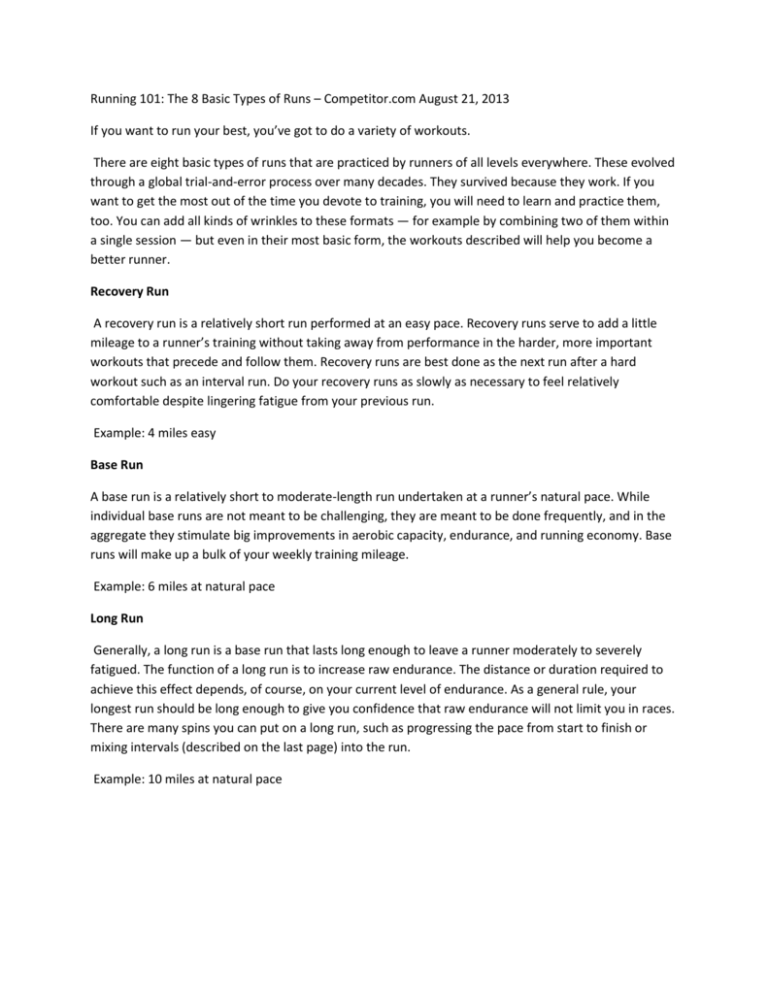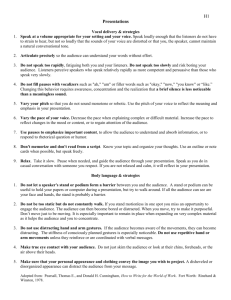Running 101: The 8 Basic Types of Runs – Competitor.com August
advertisement

Running 101: The 8 Basic Types of Runs – Competitor.com August 21, 2013 If you want to run your best, you’ve got to do a variety of workouts. There are eight basic types of runs that are practiced by runners of all levels everywhere. These evolved through a global trial-and-error process over many decades. They survived because they work. If you want to get the most out of the time you devote to training, you will need to learn and practice them, too. You can add all kinds of wrinkles to these formats — for example by combining two of them within a single session — but even in their most basic form, the workouts described will help you become a better runner. Recovery Run A recovery run is a relatively short run performed at an easy pace. Recovery runs serve to add a little mileage to a runner’s training without taking away from performance in the harder, more important workouts that precede and follow them. Recovery runs are best done as the next run after a hard workout such as an interval run. Do your recovery runs as slowly as necessary to feel relatively comfortable despite lingering fatigue from your previous run. Example: 4 miles easy Base Run A base run is a relatively short to moderate-length run undertaken at a runner’s natural pace. While individual base runs are not meant to be challenging, they are meant to be done frequently, and in the aggregate they stimulate big improvements in aerobic capacity, endurance, and running economy. Base runs will make up a bulk of your weekly training mileage. Example: 6 miles at natural pace Long Run Generally, a long run is a base run that lasts long enough to leave a runner moderately to severely fatigued. The function of a long run is to increase raw endurance. The distance or duration required to achieve this effect depends, of course, on your current level of endurance. As a general rule, your longest run should be long enough to give you confidence that raw endurance will not limit you in races. There are many spins you can put on a long run, such as progressing the pace from start to finish or mixing intervals (described on the last page) into the run. Example: 10 miles at natural pace Progression Run A progression run is a run that begins at a runner’s natural pace and ends with a faster segment at anywhere from marathon down to 10K pace. These runs are generally intended to be moderately challenging—harder than base runs but easier than most threshold and interval runs. Because they’re a medium-effort workout, the recovery time is less than more intense sessions. Example: 5 miles at natural pace + 1 mile at half-marathon pace + 1 mile at recovery pace. Fartlek A fartlek workout is a base run that mixes in intervals of varying duration or distance. It’s a good way to begin the process of developing efficiency and fatigue resistance at faster speeds in the early phases of the training cycle, or to get a moderate dose of fast running later in the training cycle in addition to the larger doses provided by tempo/threshold and interval workouts. They can also serve as a lessstructured alternative to a traditional interval session such as a track workout. Example: 6 miles at natural pace with 10 x 1:00 pickups at 5K pace with 1:00 recoveries mid-run Hill Repeats Hill repeats are repeated short segments of hard uphill running. They increase aerobic power, highintensity fatigue resistance, pain tolerance, and run-specific strength. The ideal hill on which to run hill repeats features a steady, moderate gradient of 4 to 6 percent. Hill repetitions are typically done at the end of the base-building period as a relatively safe way to introduce harder high-intensity training into the program. Example: 2 miles of easy jogging (warm-up) + 10 x 45-second hill repeats at a hard effort with 2-minute jogging recovery between reps + 2 miles easy jogging (cool-down) Threshold Run A threshold run is a sustained effort at lactate threshold intensity, which is the fastest pace that can be sustained for one hour in highly fit runners and the fastest pace that can be sustained for 20 minutes in less fit runners. Threshold runs serve to increase the speed you can sustain for a prolonged period of time and to increase the time you can sustain that relatively fast pace. Example: 1 mile of easy jogging (warm-up) + 4 miles at threshold pace + 1 mile of easy jogging (cooldown) There is a specific type of tempo run that is known as a Half-Marathon or Marathon pace run. A prolonged run at race pace is a good workout to perform at a very challenging level in the final weeks of preparation for a half-marathon or marathon, after you’ve established adequate raw endurance with long runs and longer progression runs featuring smaller amounts of pace running. Example: 2 miles at natural pace + 10 at Half Marathon or Marathon pace, final mile recovery. Intervals Interval workouts consist of repeated shorter segments of fast running separated by slow jogging or other active recoveries. This format enables a runner to pack more fast running into a single workout than he or she could with a single prolonged fast effort to exhaustion. Interval workouts are typically subcategorized as short intervals and long intervals, and are often performed on the track. Long intervals are 600 to 1,200-meter segments run in the range of 5K race pace with easy jogging recoveries between them. They’re an excellent means of progressively developing efficiency and fatigue resistance at fast running speeds. Example: 1 mile of easy jogging (warm-up) + 5 x 1K at 5K race pace with 400m jogging recoveries + 1 mile of easy jogging (cool-down) Short intervals are 100 to 400m segments run at roughly 1,500m race pace or faster. They boost speed, running economy, fatigue resistance at fast speeds and pain tolerance. Distance runners typically use shorter, faster intervals earlier in the training cycle to increase their pure speed and then move to slightly longer, endurance-based intervals to improve fatigue resistance. Example: 1 mile of easy jogging (warm-up) + 10 x 300m at 1 mile race pace with 200m jogging recoveries + 1 mile of easy jogging (cool-down)






